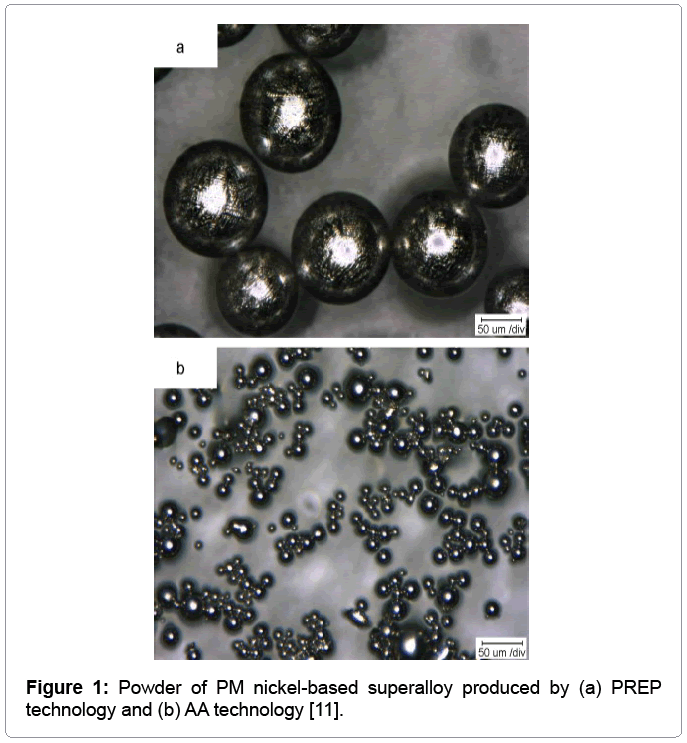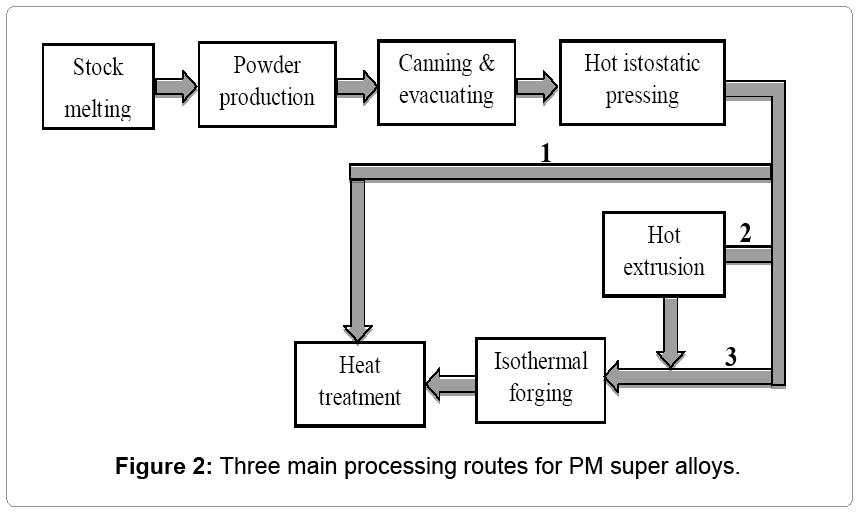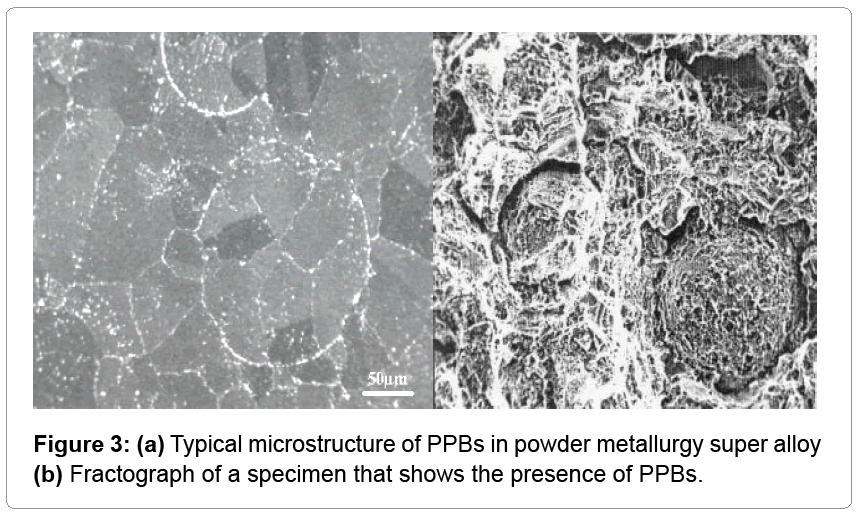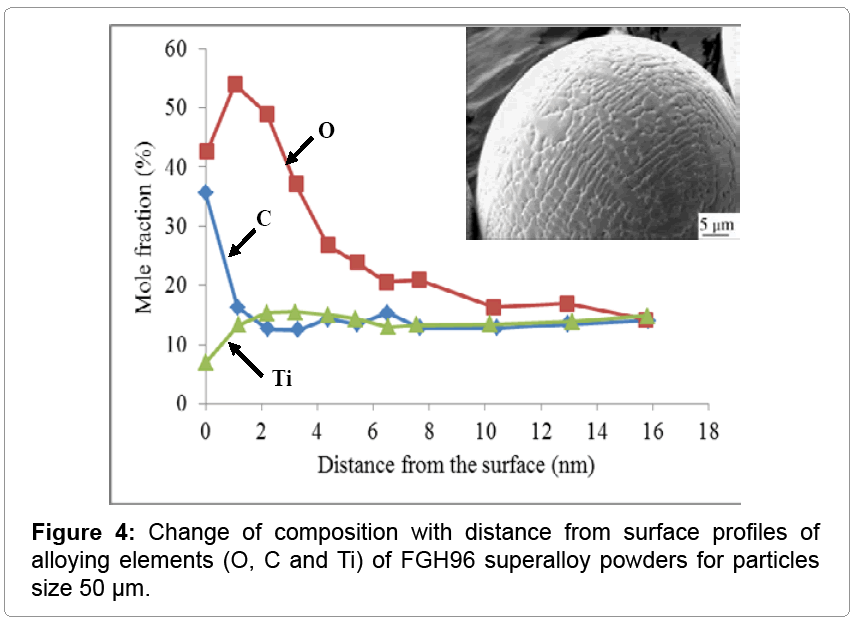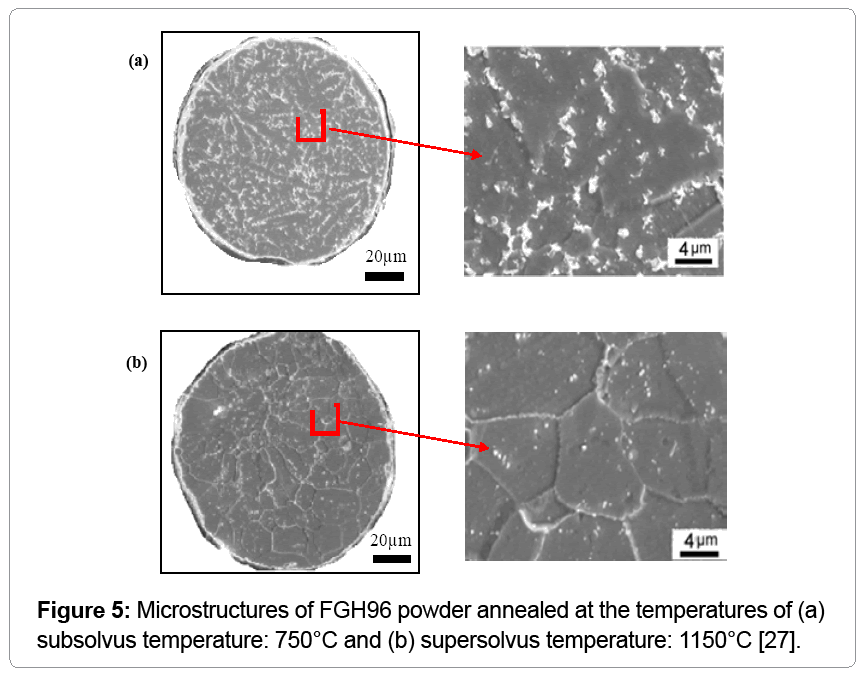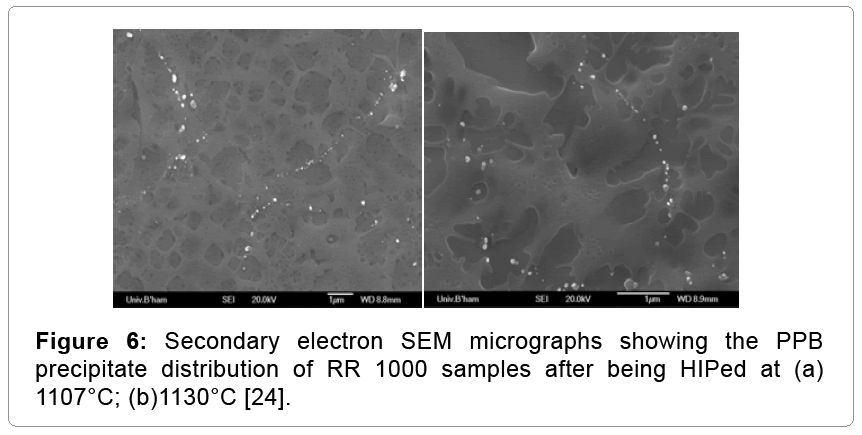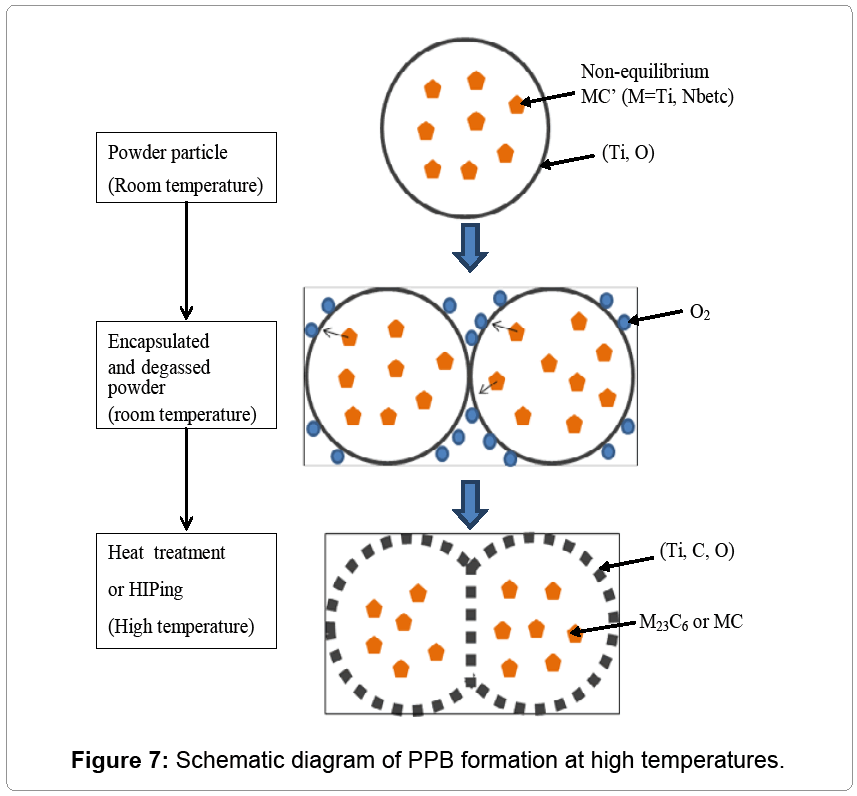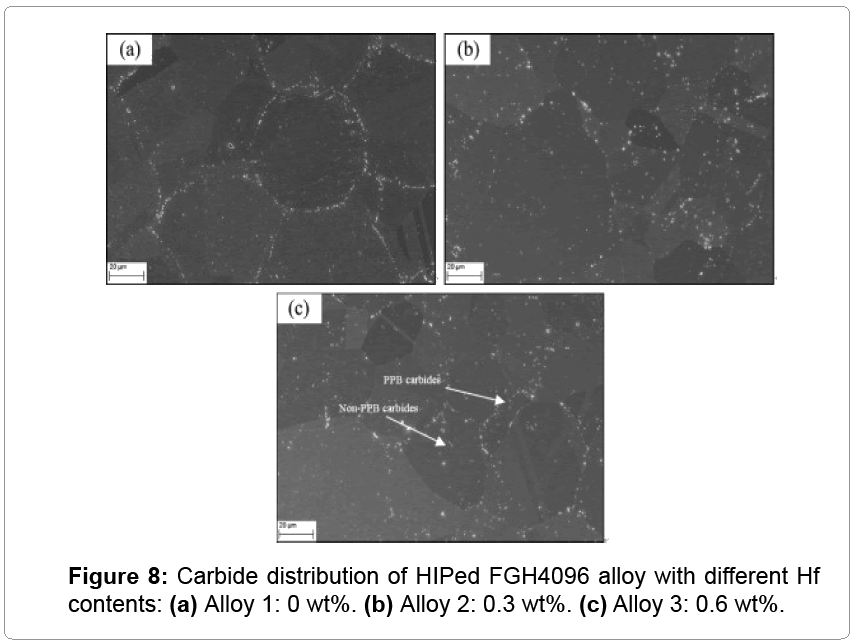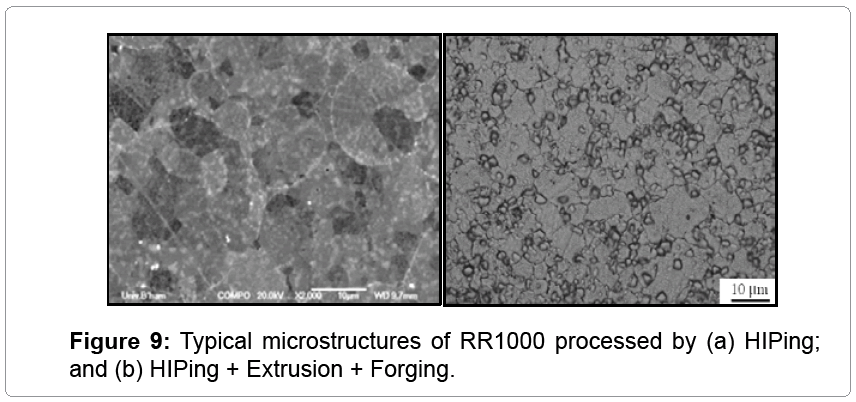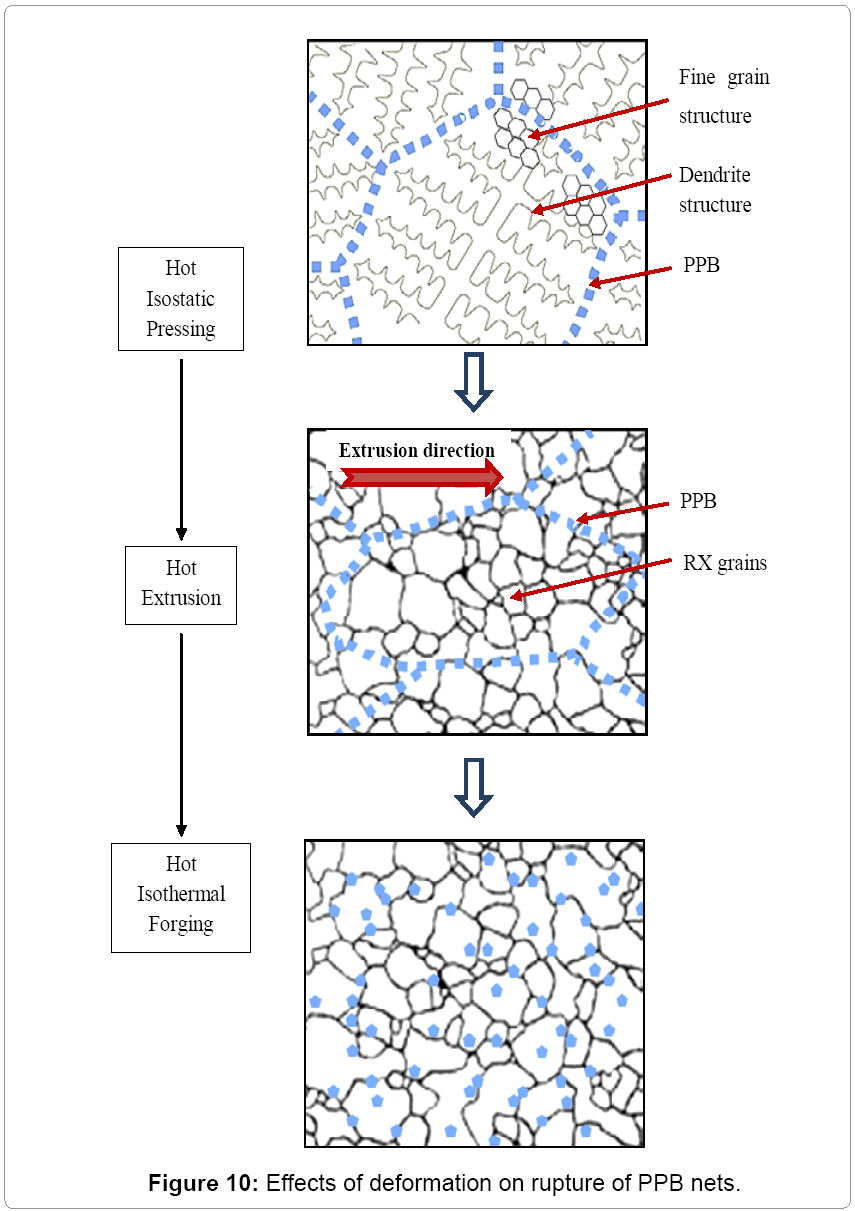Review Article Open Access
Review and Analysis of Powder Prior Boundary (PPB) Formation in Powder Metallurgy Processes for Nickel-based Super Alloys
Bai Q1*, Lin J1, Tian G2, Zou J2 and Dean TA31Department of Mechanical Engineering, Imperial College London, London SW72AZ, UK
2Beijing Institute of Aeronautical Materials, Beijing 100095, China
3Departments of Mechanical Engineering, University of Birmingham, Birmingham B15 2TT, UK
- *Corresponding Author:
- Bai Q
Department of Mechanical Engineering
Imperial College London, London SW7 2AZ, UK
Tel: +44 (0)20 75949078
E-mail: q.bai08@imperial.ac.uk
Received Date: January 01, 2015; Accepted Date: March 31, 2015; Published Date: April 07, 2015
Citation: Bai Q, Lin J, Tian G, Zou J, Dean TA (2015) Review and Analysis of Powder Prior Boundary (PPB) Formation in Powder Metallurgy Processes for Nickelbased Super Alloys. J Powder Metall Min 4:127. doi: 10.4172/2168-9806.1000127
Copyright: © 2015 Bai Q, et al. This is an open-access article distributed under the terms of the Creative Commons Attribution License, which permits unrestricted use, distribution, and reproduction in any medium, provided the original author and source are credited.
Visit for more related articles at Journal of Powder Metallurgy & Mining
Abstract
Powder metallurgy of nickel-based super alloys have been developed and used for a wide range of products, owing to their excellent high temperature rupture life, creep strength and fatigue crack growth resistance. Typical processes for high performance PM super alloys include hot isostatic pressing (HIPing), hot extrusion and hot isothermal forging. Hot isostatic pressing is normally conducted at a high temperature by using metal forming standards at low pressure for a long time. However an intrinsic problem, i. e. powder prior boundary (PPB) precipitate networks, can occur in the HIPing process. In this paper, a comprehensive review of PPB formation in the powder metallurgy of super alloys is presented. Research on PPB formation process from room temperature to high temperature and during HIPing, has been reviewed and PPB formation mechanisms are discussed. Methods to reduce PPB effects on the mechanical properties of nickel-based super alloys, including heat treatment, changing the proportions of composition elements, and plastic deformation to break up the PPB networks, are reviewed.
Keywords
Nickel-based super alloys; Powder processing; Powder prior boundary (PPB); Hot isostatic press (HIP); Forging
Introduction
Nickel-based super alloys have been widely used as high temperature structural materials in gas turbine engine applications owing to their excellent high temperature rupture life, corrosion and oxidation resistance [1,2]. The increasing trend of higher operating temperatures and pressure ratios in aero engines require nickel-based super alloys with even higher alloying content to give increased levels of creep resistance, greater low cycle fatigue resistance, with micro structural stability and damage tolerance at the elevated temperatures [1]. However due to the complex chemistry and high alloying content of these super alloys, macro segregation and coarse grain size occurs in the convectional cast and wrought processes [3]. A powder metallurgy (PM) route can eliminate macro segregation since the biggest amount of segregation in the parts produced by PM methods is limited by particle size [4]. In addition, by using PM methods micro structural control can be enhanced and thus component performance can be improved [5]. Also, complex net-shaped components can be produced by some PM technologies [6], such as hot isostatic pressing [7], metal injection moulding [4], additive layer manufacturing [8,9] and laser deposition manufacturing [10]. Two typical powder production methods for nickel-based super alloys are Argon Atomisation (AA) and Plasma Rotating Electrode Process (PREP). In the AA process molten super alloy is poured through a preheated tundish system into a gas nozzle where the melt stream is disintegrated by high pressure inert gas stream into the formation of fine particles. PREP technology uses a plasma arc to melt a high-speed rotating alloy bar, and liquid droplets that are flung off by centrifugal force are solidified in inert gas. The differences between AA powder and PREP powder are mainly in particle shape, density and size range. Figure 1 shows the powder produced by PREP and AA technology. It can be seen that AA powder normally consists of spherical particles with few small particles attached and micro-crystalline structures with fine dendrite can be found [1] due to higher cooling rates. AA powder can be produced to be very fine. PREP powder exhibits single uniform spherical shape and relatively large size around 100 μm [11]. Currently typical methods for processing high performance PM super alloys include: hot isostatic pressing (HIPing) [7], HIP+ hot isothermal forging (HIFing) [12-14] and HIPing+ hot extrusion +HIFing [15] as shown in Figure 2. In Route 2 and 3, hot extrusion and hot isothermal forging require specialised tooling and high tonnage equipment in order to obtain final component shape. In Route 2, the extrusion operation, which provides an axisymmetric strain distribution, refines the microstructure for high-resolution ultrasonic inspection to prove its integrity and permitting hot isothermally forging [16]. HIPing process can be either a net-shape forming process [17,18], as for Route 1 in Figure 2, or simply a hot compaction process, as shown in Route 2 and 3. As a netshape process, HIPing has been used for turbine discs of aero engines by VILS Stock Co, using PREP powder since 1976 [1]. However, for most AA powder, three intrinsic problems can arise when it is HIPed. They are: prior particle boundary (PPB) precipitate networks [19-22], thermal induced porosity (TIP) and ceramic inclusion [23]. During HIPing, trace amounts of gas entrapped in powder particles could be compressed and dissolved into the powder particle surface under high temperature and high pressure; As a consequence, during subsequent high temperature heat treatment, TIP may be found in the HIPed super alloys. TIP can be decreased by evacuating the gas in the encapsulated powder and selecting appropriate post-HIPing solution treatment temperature. In AA powder, due to the contact between molten super alloys and ceramic lining of the atomising nozzle, ceramic inclusions can be found in the powder particles which reduce strength and integrity of the HIPed parts. Large ceramic inclusions can be removed by screening and sieving [1]. PPB precipitation has been the major issue which largely limits the application of net-shaped HIPing of nickel-based super alloys. It is generally believed that PPBs are caused by atomic segregation and particle contamination. Both result in precipitation at PPBs, either as carbides, oxides, oxy-carbides, or possibly as oxy-carbonitrides [24]. The undesirable PPBs may result in detrimental mechanical properties: PPB precipitates are brittle and thus provide an easy fracture path. A typical microstructure of PPBs in Russian PM super alloy EP741NP is shown in Figure 3a and b shows PPBs on the fracture surface of a laboratory tensile test, in which the presence of PPBs has led to lower ductility and inferior stress rupture properties. Therefore understanding the formation of PPB mechanisms and developing methods to control PPB effects are of importance for producing high performance PM super alloy components [25,26].
PPB Formation
Since PPBs have been one of the critical issues for net-shaped HIPing, much research of PPB formation mechanisms has been carried out. In this paper, characterisation of initial powder at room temperature, powder at high temperature and powder during HIP processing, are reviewed.
Initial powder at room temperature
Zhang et al. [27] studied the effect of cooling rate during powder atomisation. They found that a higher cooling rate results in smaller particles, and they also observed that a large amount of carbide precipitates are distributed in the dendrite and at cell boundaries for a high cooling rate. At room temperature, metallic oxides, carbides and oxy-carbides can be found on powder surfaces after the liquid super alloy atomisation. Rao et al. [28] stated that PPB precipitation in super alloy Inconel is attributed to the atomic segregation and oxygen induced surface contamination of pre-alloyed powders. They explained that elements such as Al and Ti react with the absorbed oxygen and form the highly stable oxides (Al2O3 and TiO2) at the powder surface. Liu et al. [29] analysed the chemical composition on particle surfaces of super alloy FGH 96 powder, using Auger electron spectroscopy (AES). They found that elements O, C and Ti segregate on particle surfaces, which consist of an absorption layer and oxy-carbide layer. The absorption layer is mainly composed of O and C atoms, while the oxy-carbide layer is characterised as Ti oxide and carbide. As shown in Figure 4, with an increase of sputtering depth, fractions of C, O and Ti elements varied significantly: in a depth range of 0-2 nm and the high fraction of O, C elements is attributed to the absorption layer of O and C atoms. The fraction of Ti increases firstly and then levels off, which indicates that for the absorption layer, O and C elements dominated; for the oxy-carbide layer, Ti, C and O elements formed. Waters et al. [30] also reported that surface analysis of the powder particles prior to hot compaction, using Auger electron spectroscopy, revealed the presence of thin oxide layers.
Powder at high temperature
Microstructural evolution of nickel-based super alloy occurs when the powder is annealed at high temperatures. Qiu [24] studied heat treatment of RR1000 at different temperatures to understand the microstructural evolution that arises. It was found that at temperatures of 900°C and above, very fine precipitates were formed on the particle surface. The precipitates coarsened and became more discrete with increasing temperature up to 1200°C. Qiu [24] also used EDX analysis to discover that precipitates formed on the particle surface during heat treatment were rich in Hf, Zr and O, which may be assigned as (Hf, Zr) oxides. On the other hand, no Hf was found on the particle surface of as-received powders. Thus it was inferred that the Hf which contributed to the formation of precipitates on particle surfaces may have come from the interior through diffusion, which finally led to the elimination of Hf segregation in the interior of particles. Another key factor affecting the number and size of precipitates was found to be oxygen. With increased oxygen level, precipitates became coarser and more continuously distributed. Liu et al. [29] found that MC’ metastable carbide precipitates formed during the quick particle solidification, after pre-heat treatment changed to stable MC carbide and M23C6 precipitates. This improves the stability and morphology of carbide in the particles. Zhang et al. [27] studied the microstructures of FGH96 powder annealed in the temperature range 750-1150°C. As shown in Figure 5a, at a carbide subsolvus temperature 750°C the inter-dendritic interstices are decorated with white carbides. The investigators compared this to the microstructure of the atomised powder and found that the amount of carbides was decreased due to their partial dissolution. As shown in Figure 5b, at a carbide super solvus temperature 1150°C, no carbides are formed at grain boundaries and a few small carbides are visible within the grains. Based on Qiu and Zhang’s work, it can be deduced that at high temperature the decreased amount of carbide inside the powder can be attributed to dissolution at elevated temperature, and diffusion to particle surfaces which form PPBs.
Powder during HIPing process
During HIPing, powder is exposed to both elevated temperature and pressure. It is thought that during the initial stages of densification titanium and carbon within the powder migrate to particle surfaces as a result of existing surface oxides [31]. Rao et al. [28] reasoned that the oxides (Al2O3 and TiO2) at particle surfaces, act as the nuclei for preferential precipitation of MC-type carbides along the particle boundaries, either during HIPing process, or during post HIPing heat treatment process. Qiu [20] found that during HIPing, PPB is formed by the diffusion of Hf and Zr from the interior of powder particles to the particle surfaces where the oxygen level is usually high. Stolz [32] also thought that during the initial stages of densification in HIPing titanium and carbon within the powder migrate to the particle surfaces as a result of the oxides existing there. With regard to the morphology of PPB, Qiu [24] found that these precipitates were not continuously distributed like a film but instead were discrete particles. But Stolz [32] stated that the migration of titanium and carbon within the powder results in a film of stable titanium oxy-carbides on the PPBs. With regard to HIPing temperature, Qiu [24] examined PPB precipitate distribution of samples after HIPing at different temperatures, shown in Figure 6, and stated that no great difference could be distinguished in precipitate size and distribution after HIPing at different temperatures below the gamma prime solvus around 1160°C. However, HIPing at super-solvus temperatures results in grains in the original particles growing beyond PPBs, which reduces the density of PPBs in HIPed samples, compared with those samples HIPed at a lower sub-solvus temperature [20]. With regard to the particle size, Stolz [32] found that larger particles are strained to a much smaller degree than small particles during a typical HIP cycle. PPB networks tend to form on these larger less-deformed powder particles. However May et al. [33] found that a greater degree of PPB decoration occurs in the finer powder particle size fraction, and following a super-solvus heat treatment these PPBs pin grain boundaries of the fine powder particle, while the reduction of PPB decoration in coarse powder particle compacts allows significant grain growth.
PPB formation mechanisms
Most researchers are of the opinion that oxides at particle surfaces are preferential nucleation sites for carbides [28,32,34], but a few claim that the metal-metal interfaces are the preferential precipitation sites [35]. The formation mechanism of the former mechanism is shown schematically in Figure 7. At room temperature, carbides formed both on the surface and within the powder interior can be observed in inter dendritic and in intercellular regions [23]. The non-equilibrium carbides are predominantly metal carbides of the form MC’ since elements such as Ti, Nb and Mo were detected [5]. After the powder has been encapsulated and the envelope evacuated of air, the absorbed oxygen at the powder surface can react with Al and Ti and form an oxide layer of Al2O3 and TiO2 and so forth [5]. During HIPing and heat treatment, that preliminary surface oxidation aids the subsequent precipitation of MC since specific oxide particles act as nuclei for the formation of MC or M23C6 [5]. It is thought that during the initial stages of densification in HIPing that titanium and carbon within the powder migrate to particle surfaces as a result of oxides on the outside of the particles [32].
Methods to Reduce the Detrimental Effect of PPBs
Many researchers have been working on methods to reduce PPB effects, by optimising heat treatment and the proportion of composition elements, and introducing deformation.
Heat treatment
Zhang et al. [27] found that powder heat treatment can reduce prior particle boundaries. The fundamental mechanism of powder heat treatment is based on the control of carbide precipitation. Dahlen et al. [36] found that powder heat treatment can stabilise carbides in the form of MC and M23C6 at the interior of particles, resulting in the hindrance of re-precipitation at PPBs. Qiu et al. [20] deduced that HIPing at super-solvus temperatures reduced the density of PPBs compared with the density observed in samples HIPed at sub-solvus temperatures, by making grains within the original powder particles grow beyond the precipitates of PPBs, thus resulting in larger grains with serrated boundaries.
Proportion of composition elements
Ma et al. [37] studied the effect of Hfon carbides with different Hf content in FGH96. They classified the carbides in HIPed FGH4096 alloys into PPB carbides which are distributed on PPBs, and non-PPB carbides which are distributed internally, as shown in Figure 8. From electron diffraction patterns, they found that the formation of PPB MC was suppressed in the alloy with 0.3 wt % Hf, but more MC precipitated at PPBs when Hf content of the alloy was raised to 0.6 wt %. As a strong carbide forming element, Hf promotes the formation of MC carbides. Hf increases the number of insoluble MC nuclei by stabilising the interior MC, thus the amount of non-PPB carbides is increased with increasing of Hf. However, more oxide nuclei are formed at PPBs as Hf content increases, which promote the precipitation of PPB carbides. They concluded that the recommended Hf content in FGH4096 alloy, for minimising PPB carbides, is around 0.3 wt %. Janowski et al. [38], Chen et al. [39] and Wu et al. [40] also found that Hf promotes the precipitation of blocky MC by increasing the interfacial misfit between the MC/matrix interfaces, and retards the transformation of MC to M23C6 during long-time aging at intermediate temperatures.
Effect of deformation on PPBs
It is found that heat treatment and changing the composition of super alloys can reduce the effect of PPBs to some extent. Thermo-mechanical processing steps such as rolling, extrusion and forging operations can break up PPB networks efficiently [16] (Figure 9). Rao et al. [41] rolled HIPed IN718 to 40% reduction, and found that PPBs were eliminated completely. A very fine recrystallized grain structure with uniform precipitation of strengthening phases was obtained and thereby a great improvement in high temperature mechanical properties. Hardy [42] defined an industrial process to reduce the effect of PPBs in Nickelbased super alloy RR1000. Following consolidation of canned powder by hot isostatic pressing or hot compaction, extrusion of the cans with a reduction ratio greater than 4. 5:1 is normally used. The purpose of the extrusion stage is to break down any PPBs and to produce a fine grain size that is typically smaller than 6 μm. This structure is ideal for inspection of the billet and subsequent superplastic deformation of isothermal forging. Hot forging or isothermal forging is used to produce the desired finished shape and grain structure. Since lower strain rates are used during deformation, isothermal forging at slow strain rates and high temperatures (slightly below the γ’ solvus) [43] currently offers greater control on structure and enables quire complexity, nearnet shaped components to be formed [44]. May et al. [33] stated that for critical applications such as disc rotor components in aero-engines, the consolidated alloy powder particles should be extruded to break down carbide and oxide networks, i. e. PPBs, and to refine the grain size for isothermal forging. Mourer et al. [45] produced a billet of René 104 with a diameter of 235 mm, from which to manufacture a military aircraft engine high pressure turbine disk with dual microstructures. Two extrusions and isothermal forging were employed to produce the finished parts. Extrusion and isothermal forging were also used for producing a preform for a dual alloy disk of SR3 bore - KM4 rim [46]. A schematic of the effect of plastic deformation is shown in Figure 10. After hot isostatic pressing, a certain degree of dendrite structure and fine grain structure can be found in the material, depending on HIPing temperature, pressure and time. Due to the long-time of exposure to elevated temperature, Ti, Al and other metal elements diffuse to particle surfaces and react with oxygen in a trace amount of the absorbed air, and thus PPBs are precipitated during HIPing. Through hot extrusion, powder particles as well as PPBs are elongated along the direction of material flow. Recrystallization can be found in the material and the grains are refined significantly due to the severe plastic deformation, and therefore the PPB networks are ruptured. In the hot forging or hot isothermal forging that follows, grains grow due to the elevated temperature and thus PPB fragments are distributed throughout the material. Therefore the detrimental effect of PPB on the mechanical properties is reduced, and the strength and reliability of the material are increased.
Summary and Conclusions
Prior particle boundaries are significant defects in As-HIPed AA powder super alloy, and can reduce low cycle fatigue resistance. Formation of PPBs is related to temperature and time since it is a diffusion process. Many researchers have proposed that pre-heat treatment, proper HIP temperatures and material composition can reduce the effect of PPB to a certain extent. Furthermore, deformation such as extrusion and forging can rupture PPBs and greatly reduce their detrimental effects. It is important to gain further understanding of the formation mechanisms of PPB, and thus to develop novel processes in which the formation of PPB can be controlled. Since the formation of PPBs mainly takes place during HIPing, it is important to develop a process, in which the time of exposure to elevated temperature can be shortened, plastic deformation can be introduced to disperse the existing PPBs and the desired and final shape of the component can be achieved. Due to the oxide on the surface of powders, PPB formation is an intrinsic problem in powder metallurgy of Nickel-based super alloys. It is very important to establish a standard to quantify and determine the acceptable amount and morphology of PPB.
Acknowledgements
Much appreciated is the strong support received from the Beijing Institute of Aeronautical Materials (BIAM), for this funded research. The research was performed at the AVIC Centre for Materials Characterisation, Processing and Modelling at Imperial College London.
References
- Williams B (2012)Powder metallurgy superalloys for high temperature, high performance applications. International Powder Metallurgy Directory (15thedn).
- Key role for PM in civil aircraft engine project. Metal Powder Report.
- Couturier R (2004) Process development and mechanical properties of alloy U720LIfor high temperature turbine disks, in superalloys.In: TMS: Champion K.A. Green. Pennsylvania.
- Ozgun O (2013) Microstructural and mechanical characterization of injection molded 718 superalloy powders. Journal of Alloys and Compounds 576: 140-153.
- Crompton JS, Hertzberg RW (1986) Analysis of second phase particles in a powder metallurgy HIP nickel-base superalloy. Journal of Materials Science 21: 3445-3454.
- Yuan WX (2007) Computer modelling and tooling design for near net shaped components using hot isostatic pressing. Journal of Materials Processing Technology 182: 39-49.
- Raisson JYG, Guichard d, Rongvaux JM (2011) Production of Net-Shape Static Parts by Direct HIPing of Nickel Base SuperalloyPrealloyed Powders. Advanced Materials Research 278: 277-282.
- Cooper DE (2013) Additive layer manufacture of Inconel 625 metal matrix composites, reinforcement material evaluation. Journal of Materials Processing Technology 213:2191-2200.
- Bi G (2010) Feasibility study on the Laser Aided Additive Manufacturing of die inserts for liquid forging. Materials & Design 31:S112-S116.
- LiJ, Wang HM (2010) Microstructure and mechanical properties of rapid directionally solidified Ni-base superalloy Rene41 by laser melting deposition manufacturing. Materials Science and Engineering: 527: 4823-4829.
- Zhang MJ, Li FG, Wang SY, Liu CY (2011) Effect of powder preparation technology on the hot deformation behavior of HIPed P/M nickel-base superalloy FGH96. Materials Science and Engineering: A 528:4030-4039.
- Alniak MO, Bedir F (2006) Change in grain size and flow strength in P/M Rene 95 under isothermal forging conditions. Materials Science and Engineering: B 130: 254-263.
- Semiatin SL (2013) Plastic flow and microstructure evolution during thermomechanical processing of a PM Nickel-base superalloy. Metallurgical and Materials Transactions 44: 2778-2798.
- Ng LS, Loh NL, Boey FYC (1997) Cold-hot isostatic pressing of Mar M200 superalloy powders. Journal of Materials Processing Technology 67: 143-149.
- Mitchell RJ, Ramanathan R, Li HY, Perkins KM, Connor LD,et al.(2008) Process development & microstructure & mechanical property evaluation of a dual microstructure heat treated advanced nickel disc alloy.Superalloys.
- Banik A, Hardy MC, Mourer DP, Reay T (2004) Low cost powder metal turbine components.Superalloys.
- Helle AS, Easterling KE, Ashby MF (1985) Hot-isostatic pressing diagrams: New developments. Acta Metallurgic 33: 2163-2174.
- Arzt E, Ashby MF, Easterling KE (1983) Practical applications of hot isostatic pressing diagrams: four case studies. Metallurgical Transactions 14: 211-221.
- Qiu C (2013) Influence of heat treatment on microstructure and tensile behavior of a hot isostatically pressed nickel-based superalloy. Journal of Alloys and Compounds 578: 454-464.
- Qiu CL (2013) Influence of hot isostatic pressing temperature on microstructure and tensile properties of a nickel-based superalloy powder. Materials Science and Engineering: A 564: 176-185.
- Bampton C, Daam TV, Creeger G, James S (2005) Net-Shape HIP Powder Metallurgy Components for Rocket Engines. Proceedings of International Conference on Hot Isostatic Pressing, HIP'05, California, USA
- Terzi S (2008) Modelling the plastic deformation during high-temperature creep of a powder-metallurgy coarse-grained superalloy. Materials Science and Engineering: A 483: 598-601.
- Gessinger GH (1974) Powder Metallurgy of superalloys. Butterworths monographs in materials, London: Butterworths 19: 51-76.
- Qiu C (2010) Net-shape hot isostatic pressing of a nickel-based powder superalloy in Department of Metallurgy and Materials.The University of Birmingham, Birmingham.
- Radavich JDF (2004) Assessment of Russian P/M superalloy EP741NP in Proceedings of the Tenth International Symposium on Superalloys. Pennsylvania.
- Rao GA (2003) Effect of standard heat treatment on the microstructure and mechanical properties of hot isostatically pressed superalloyinconel 718. Materials Science and Engineering: A 355: 114-125.
- Zhang L(2012) Thermal evolution behavior of carbides and γ'precipitates in FGH96 superalloy powder. Materials Characterization67: 52-64.
- Rao GA, Srinivas M, Sarma DS (2006) Effect of oxygen content of powder on microstructure and mechanical properties of hot isostatically pressed superalloy Inconel 718. Materials Science and Engineering: A 435: 84-99.
- Liu JYZ (2012) AES analysis and pre-heat treatment of FGH96 superalloy powders.The Chineses Journal of Nonferrous Metals 22: 2797-2804.
- Waters RE, Charles JA, Lea C (1981) Prior particle boundaries in hot isostatically pressed nickel-based superalloy, studied by Auger electron spectroscopy. Metals Technology 8: 194-200.
- Aubin C (1980) The Influence of Powder Particle Surface Composition on the Properties of a Nickel-Based Superalloy Produced by Hot Isostatic Pressing,Superalloys.
- Stolz DS (2004) Effect of a supersolvus heat treatment on the microstructure and mechanical properties of a powder metallurgy processed nickel-base superalloy, PhD thesis, University of Florida.
- May JR(2011) Microstructure and mechanical properties of an advanced nickel-based superalloy in the as-HIP form. Advanced Materials Research 278: 265-270.
- Maurer GE, Schweizer FA, Mancuso S (1996) Development of HIP consolidated P/M superalloys for conventional forging to gas turbine engine components.Superalloys.
- Fischmeister MD (1980) Carbide Precipitation in Superalloys. Tien JK, Morrow H III, Gell M, Maurer GE (Eds.). The Metallurgical Society of AIME 449-454.
- Dahlén M,Winberg L (1980)The influence of γ-precipitation on the recrystallization of a nickel base superalloy. ActaMetallurgica28: 41-50.
- Ma W(2013) Effect of Hf on carbides of FGH4096 superalloy produced by hot isostatic pressing. Materials Science and Engineering 587: 313-319.
- Janowski GM, Harmon BS, Pletka BJ(1987) thermal stability of the nickel-base superalloy b-1900 plus hf with tantalum variations. Physical metallurgy and materials science 18: 1341-1351.
- Chen QZ, Jones CN, Knowles DM (2002) Effect of alloying chemistry on MC carbide morphology in modified RR2072 and RR2086 SX superalloys.ScriptaMaterialia 47: 669-675.
- Wu k (2012) Alloy Design of a New Type High-Performance P/M Turbine Disk Superalloy. Procedia Engineering 27: 939-953.
- AppaGR, Sarma DS (2004) Effect of thermomechanical working on the microstructure and mechanical properties of hot isostatically pressed superalloy Inconel 718. Materials Science and Engineering: A 383: 201-212.
- Hardy MC, Shen G, Shankar R (2004)Developing damage tolerance and creep resistance in a high strength nickel alloy for disk applications. Superalloy.
- Blankenship CP, Henry MF, Hyzak JM, Rohling RB, Hall EL (1996) Hot-die forging of P/M Ni-base superalloys.Superalloys.
- Shen G, Furrer D (2000) Manufacturing of aerospace forgings. Journal of Materials Processing Technology 98: 189-195.
- Mourer DP (2004) Dual heat treat process development for advanced disk applications.Superalloys.
- Mourer DP, Ganesh S, Hyzak J (1996) Dual alloy disk development.Superalloys.
Relevant Topics
- Additive Manufacturing
- Coal Mining
- Colloid Chemistry
- Composite Materials Fabrication
- Compressive Strength
- Extractive Metallurgy
- Fracture Toughness
- Geological Materials
- Hydrometallurgy
- Industrial Engineering
- Materials Chemistry
- Materials Processing and Manufacturing
- Metal Casting Technology
- Metallic Materials
- Metallurgical Engineering
- Metallurgy
- Mineral Processing
- Nanomaterial
- Resource Extraction
- Rock Mechanics
- Surface Mining
Recommended Journals
Article Tools
Article Usage
- Total views: 19761
- [From(publication date):
April-2015 - Apr 03, 2025] - Breakdown by view type
- HTML page views : 14633
- PDF downloads : 5128

